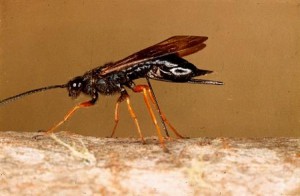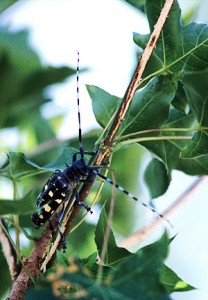
Sirex woodwasp. Photo: Maine Department of Agriculture
By Emily Lawler
Oct. 28, 2009
LANSING– Asian longhorned beetles and sirex woodwasps and hemlock woolly adelgids – Oh my!
Those three invasive species spotted in northeastern Ohio could soon ravage Michigan, and that could prove disastrous, horticulture experts warn.
“There’s not a wall between the borders,” said Amy Frankmann, executive director of the Michigan Nursery and Landscape Association in Okemos.
Michael Philip, pest survey program manager for the state Department of Agriculture (MDA), said that at least one of these species is already here.
“Sirex does occur in Michigan — it’s known in Macomb, Huron, Sanilac and St. Clair counties,” said Philip.
According to the U.S. Department of Agriculture (USDA), the sirex woodwasp is native to Europe, and kills pines by boring into them and injecting a toxic mucus and fungus while laying eggs there. There’s an 80 percent mortality rate for trees they infest.
The MDA is monitoring its effects. “It’s an unknown as to whether or not it’s going to be a serious pest,” Philip said.
A confirmed environmental threat is the hemlock woolly adelgid. This was first found in Virginia in the 1950s, and it’s headed north. Philip says it’s 100 percent lethal to hemlocks, and Michigan has 100 million such trees.
“It’s not a very important economic tree, but it’s critically important ecologically,” said Philip.
The adelgid was found in 2006 in Harbor Springs, but the MDA believes it’s been eradicated there. Nonetheless, the department has placed restrictions on moving hemlocks to make sure no more bugs sneak in.
Frankmann said, “The hemlock wooly adelgid already has a huge impact on our industry. With the quarantines placed on us, we can’t ship or export hemlock.”

Asian longhorned beetle. Photo: University of California Riverside
Another threatening species is the Asian longhorned beetle, which the USDA says targets and kills deciduous hardwoods including maple, willow, elm and ash.
According to Philip, the beetle has never been found alive in Michigan but has been found dead in cargo.
But if it gets here alive, it’s going to be dangerous. “We consider it one of the most serious threats to Michigan forests,” said Philip.
Tom Barnes, executive director of the Michigan Association of Timbermen in Newberry said, “The Asian longhorned beetle poses a huge threat to our hardwood and softwood maple resources, which is going to have an economic impact.”
Nobody wants to see another emerald ash borer, which has destroyed millions of the state’s ash since 2002. Frankmann said the discovery and resulting control cost her industry alone $10 million.
“We’re still reeling from the losses,” said Frankmann.
Barnes said Michigan’s wood pallet makers were also hard-hit by the emerald ash borer.
“They have to heat treat their pallets, and that’s an added cost. That puts them at a disadvantage in competing with other states,” he said.
In addition, public agencies and private property owners have spent uncounted millions of dollars to remove, dispose of and replace ravaged ash.
Sightings of these new invaders in Ohio were reported by members of the public, and Philip said that’s the way it will be in Michigan as well. “Reports from the public are the single most important thing we can do to find these pests early enough,” he said.
People who see the insects can contact the MDA, Department of Natural Resources or a local Michigan State University Extension office.
Emily Lawler writes for Capital News Service
© 2009, Capital News Service, Michigan State University School of Journalism. Not to be reproduced without permission.
I forgot, they were attracted to the Eco Lightbulb that I had for my outside porch light, in Marquette, MI.
Sperncer Bernstein
Envrionmental Conservation Senior, NMU
Hello, my name is Spencer I am a Senior at NMU, this past summer of 2009, I captured and then released two(2) Asian Longhorned Beetles. I know for sure because I didn’t know what kind of beetle they were but I would never forget the size and just the look of them. I am guessing a male and a female because they were very different in size at least by a centimeter. I would say that the largest one was about 3 or 4 centimeters in length without there entena, just there bodies. I read this article because I like bugs, and when I saw this here beetle. I thought I should tell someone.
Thanks for listening
Spencer